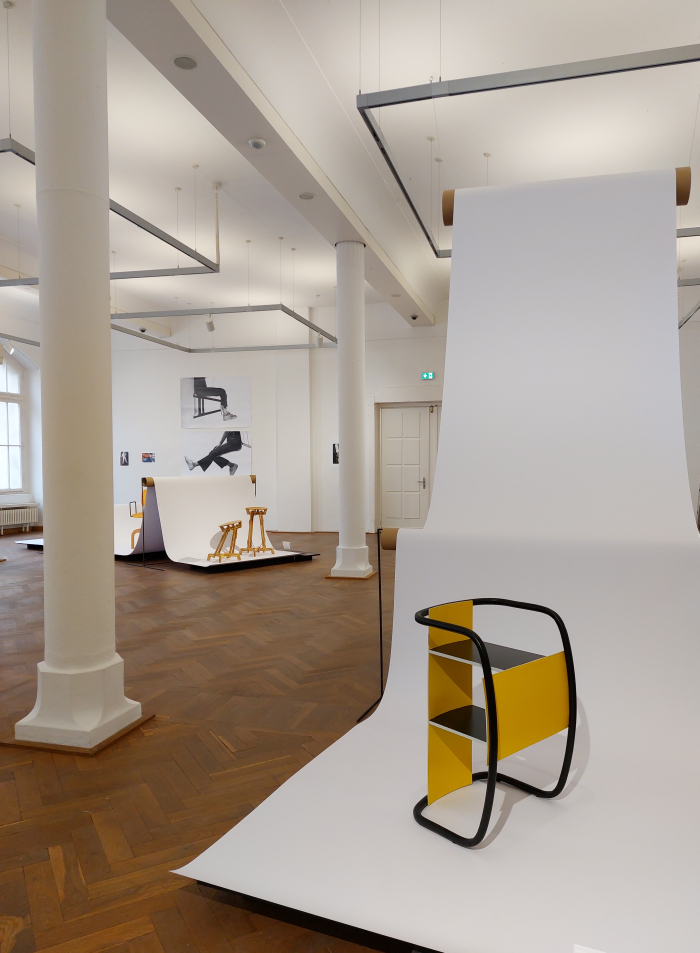Sitting reconsidered. Design, Observe, Stage at the Burg Galerie, Halle
Each and everyone of us sits innumerable times each and every day in a wide variety of contexts, yet we rarely, if ever, consider the act of sitting.
The exhibition Sitting reconsidered. Design, Observe, Stage at the Burg Galerie, Halle challenges us all to do just that…….
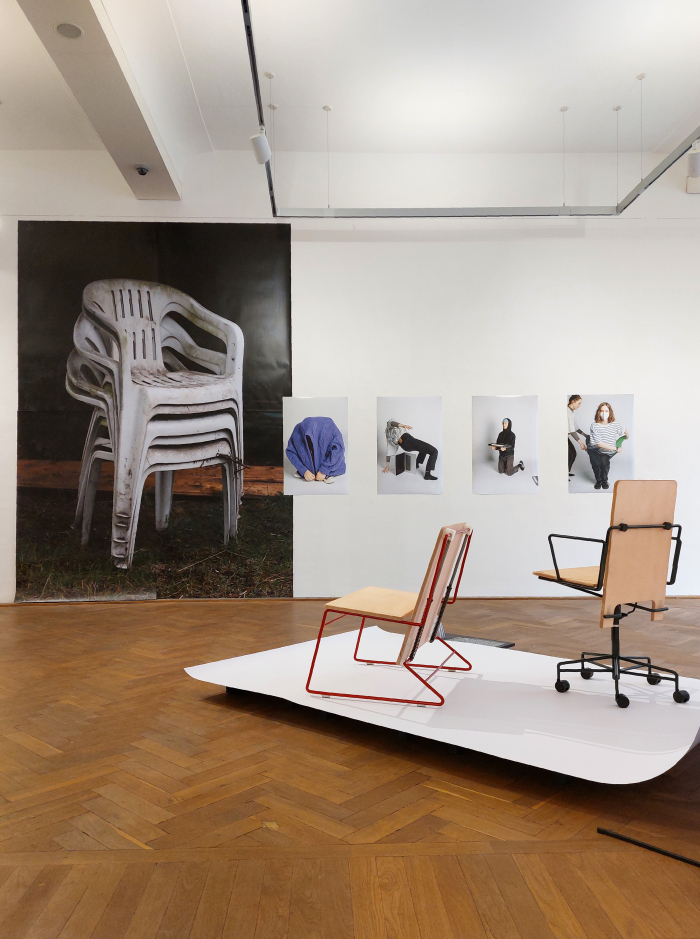
MRS1 & MRS1 Low by Luis-Konstantin Schlicht, and uncredited student photographic works, as seen at Sitting reconsidered. Design, Observe, Stage, the Burg Galerie, Halle
Originating in context of, and presented parallel to, the exhibition Chairs: Dieckmann! The Forgotten Bauhäusler Erich Dieckmann at Neuwerk 11, Sitting reconsidered. Design, Observe, Stage features the results of three student projects undertaken at the Burg Giebichenstein Kunsthochschule, Halle, during the 2021 summer semester, and which all play somewhat differently, individually, on the reconsidered of the exhibition title.
Reconsidered from the perspective of the photographer; specifically communication design students who, under the direction of Professor Stephanie Kiwitt and Felix Bielmeier, started from photos of Dieckmann’s furniture taken at the Burg in the early 1930s, thus at that period when Dieckmann taught at the Burg, and subsequently moved towards today, questioning as they travelled how chairs have historically been represented in photographs, how they are currently represented and how they could, should?, be represented. And a presentation of the students’ responses to the contemporary staging of chairs in photography which in addition to allowing for reflections on the photography of chairs in an artistic context as much as in a commercial or technical context, and allowing approaches to questions of how does one meaningfully capture a functional 3D object in a static 2D photograph, also allows for a differentiated questioning on what exactly sitting is. And the role of, relevance of, chairs in sitting. For all in our contemporary European societies.
Reconsidered from the perspective of the art pedagogue and art theorist; specifically art pedagogy and art theory students who, under the direction of Professor Dr. Sara Burkhardt, started from observations on sitting undertaken in a wide variety of locations and contexts and culminated in the development of a so-called Burg Education Box1 containing a collection cards which aside from a few short reflections (largely) by contemporaries of Erich Dieckmann on seating and sitting in context of Erich Dieckmann’s projects, also includes a series of questions and activities designed to enable alternative, fresh, otherwise unapproachable perspectives on seats and sitting, and that either individually or as a social activity with others. Questions and activities such as: Find a chair – If this chair were a human, what would be its characteristics?; Do you only use chairs to sit on?; Do you believe in timeless chair design?; Invent a chair in a minute, try it out and discover its special function?; Do you have memories in which chairs or other seating items play a role? Our answer to that last question being, we only have memories of such situations. Tragic, but true.
Reconsidered from the perspective of the industrial designer; specifically industrial design students who, under the direction of Visiting Professor Konrad Lohöfener, started with the work, the positions, the approaches of Erich Dieckmann and sought to translate those into contemporary contexts, into contemporary seating objects, to design contemporary seating in context of Erich Dieckmann.
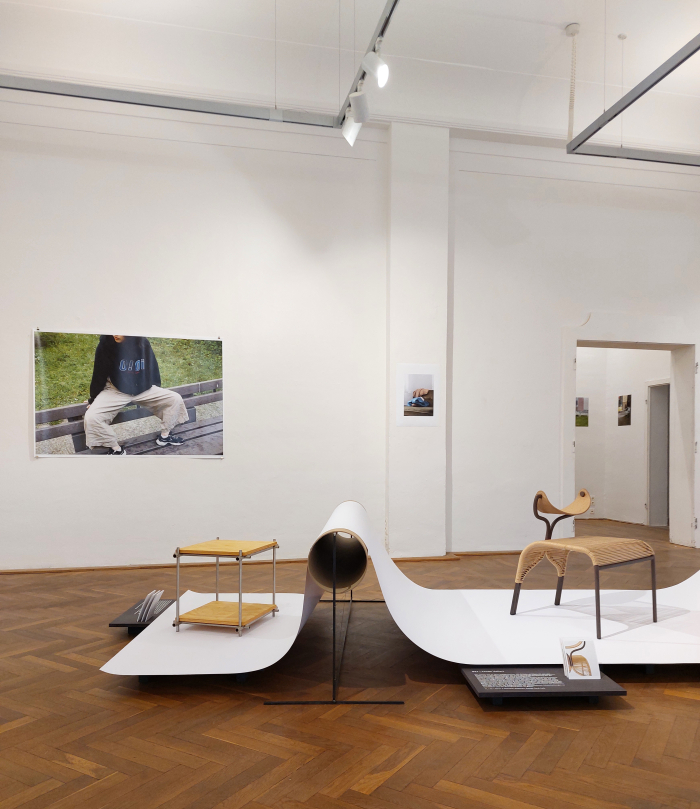
Elle by Milan Behrens (l) and Syt by Theda Vollert (r), and an uncredited photo, as seen at Sitting reconsidered. Design, Observe, Stage, the Burg Galerie, Halle
A project held under the title Zwischen den Stühlen, a title whose ambivalence about which of the myriad understandings of Zwischen one employs, whose playfulness with the word Zwischen2 as being, for example, both amongst and in-between, underscores, as Konrad Lohöfener opines, that as a project “it is not primarily about the objects themselves, but about the “between””3, if one so will, about the dialogue betwixt the projects one finds oneself amongst, the comparison of the approaches, positions and understandings represented in the works.
A project which saw the students interpret the brief in an outrageously wide context, and which isn’t a complaint, far from it, we delight in such, would wish for no other result, and are genuinely heartened to see that, at least at the Burg, Covid doesn’t appear to have led to any changes of behaviour on the part of design students, hasn’t seen design students attempt to actually follow a brief as given.
A project which alongside critically viewing and discussing Dieckmann’s work in the Burg archive, also included, and amongst other activities, a photography workshop, a workshop on Material Denken, Material Thinking, with Daniel Kern and Philipp Witte from Magazin and Florian Schregelmann from Nils Holger Moormann, a discussion on Cradle to Cradle & Circular Economy with Götz Hilber. And also saw them design the Sitting reconsidered exhibition architecture.
And a project which, and as ever with such student semester projects, the results as presented in the final exhibition are in many regards the least relevant component of; much more important is how the individual students got to that end result, the path, paths, they took there, why they changed paths, what they learned on the way, how they developed as designers, and individuals, how their position(s) to design developed, how their understanding(s) of the role of the designer evolved, how the experiences of the project inform their approach to future projects, etc, etc, etc. Such a project isn’t about the results and such a project presentation isn’t a contest where you pick out your favourite.
That said…….
We were particularly taken with Hidden Hostility by Theresa Güldenberg and Magdalena Meißner which sought/seeks to stimulate more debate about the furniture, for all the seating, of urban public spaces, and that through highlighting the control functions urban seating exerts. For Theresa and Magdalena the focal point is and was deliberate attempts to stop the homeless lying on urban seating, how the form and adornments of urban benches keep the homeless moving on in search of somewhere to lay4; but which is, we’d argue, but one of the many questions of how inclusive urban public space furniture is, the function of urban furniture, urban furniture as an expression of contemporary understandings of a democratic society. And further questions of who decides how our urban spaces are furnished, questions we all pose far too infrequently, and which, and as with all questions of the design of our urban spaces, really, really, really shouldn’t be left to politicians and architects alone.
With Dysta by Xue Song a work which reminded us formally and conceptually of Hans Brockhage and Erwin Andrä’s 1950s Schaukelwagen, an object developed under the direction of Mart Stam at the Hochschule für Bildende Künste Dresden and which started life as a rocking horse, a rocking horse of which Stam, allegedly, commented, in his best Dutch-German, “when horse fall over, horse is dead. You must make a horse that isn’t dead when it falls over”. The result is/was a child’s chair, car, chair, and rocking horse that can be used both “upside up” and “upside down”, without any understanding of, necessity of, defining what is the “upside”. Dysta can be employed in four positions, as a chair, as a perch, as a couple of rocking stools, and equally has no correct “upside”, just that mode which is most appropriate, desirable, for the given moment. And as concept in which the sitter is empowered to change not only their sitting position but the level of activity of that sitting as and when they wish, and also as a concept which enables a multi-function object that offers a great freedom of use, for all against the background of home office in small contemporary apartments, is very enticing. If an object which, for us, needs a somewhat quieter character, shouldn’t stand out as an object but as a collection of functionalities.
With MRS1 and MRS1 Low by Luis-Konstantin Schlicht, the former of which employs metal wire to sketch the silhouette of an office chair, the latter of which is a thoroughly delicious low-ish, wide seated lounger, and both of which feature stupidly simple, low-tech mechanisms for enabling the backrest to move with the sitter. As in ridiculously simple and low-tech combinations of springs and joints and buffers. Sadly testing wasn’t possible so we don’t know how well the systems work, if they are responsive and practical and comfortable and meaningful, but on the other hand such interests us but little; for as stupidly simple and low-tech systems they were a very nice reminder that while going forward ever new technology will become available, that doesn’t mean it has to be used, sometimes existing technology can provide for solutions that are not only better, but cheaper, less environmentally and socially harmful, more democratic, more communicative, more responsive, more enduring, certainly more endearing. And no, we’re not talking about flying taxis, we’re talking about chairs, furniture in general and how we furnish our spaces. That in an ever more complex world we need the simple to remind us that the complexity is our fault, our decision, that there are alternatives.
But as noted, the actual works are less important than the hows and whats and whys inherent within the works. And as Konrad Lohöfener noted “it is not primarily about the objects themselves, but about the “between””; a position that can be extended to Sitting reconsidered as a whole where the dialogue “between” the industrial design and the photography creates a space in which one has the freedom, and time, to reflect on the act of sitting.
And subsequently head out into Halle with the Burg Education Box to extend those reflections begun in a theoretical space into that real world space where we all sit innumerable times each and every day, yet rarely, if ever, consider the act of sitting.
Sitting reconsidered. Design, Observe, Stage is scheduled to run at the Burg Galerie im Volkspark, Schleifweg 8a, 06114 Halle until Sunday March 20th.
Full details can be found at www.burg-halle.de/burg-galerie/
Chairs: Dieckmann! The Forgotten Bauhäusler Erich Dieckmann is scheduled to run at the Kunststiftung Sachsen-Anhalt, Neuwerk 11, 06108 Halle until Sunday March 27th
Full details can be found at www.kunststiftung-sachsen-anhalt.de
And as ever in these times, if you are planning visiting any exhibition please familiarise yourself in advance with the current ticketing, entry, safety, hygiene, cloakroom, etc rules and systems. And during your visit please stay safe, stay responsible, and above all, stay curious……
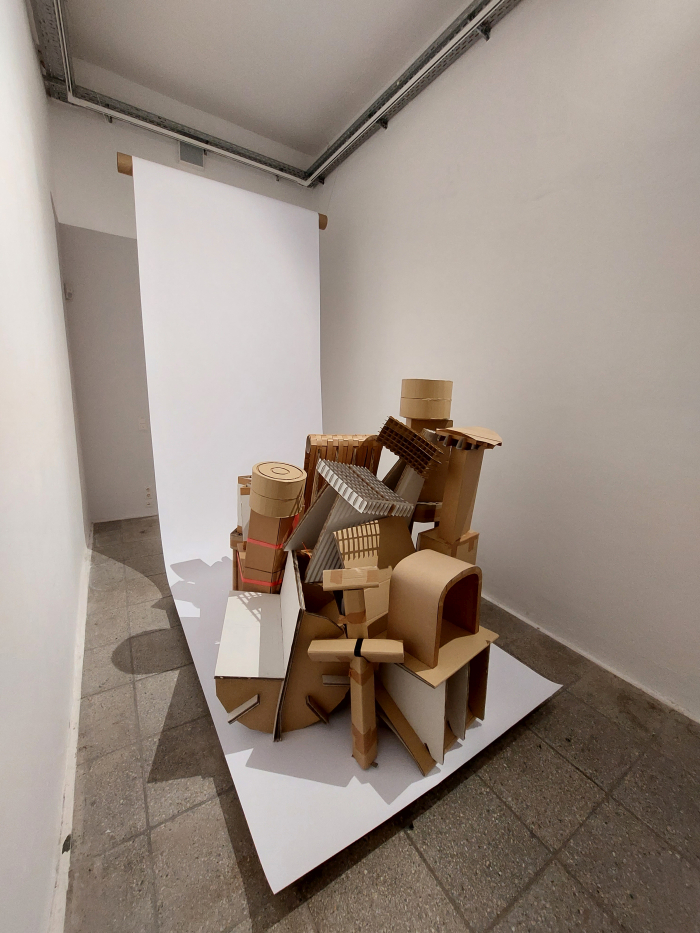
Results from the Stuhlomat workshop staged in context of the project Zwischen den Stühlen, as seen at Sitting reconsidered. Design, Observe, Stage, the Burg Galerie, Halle
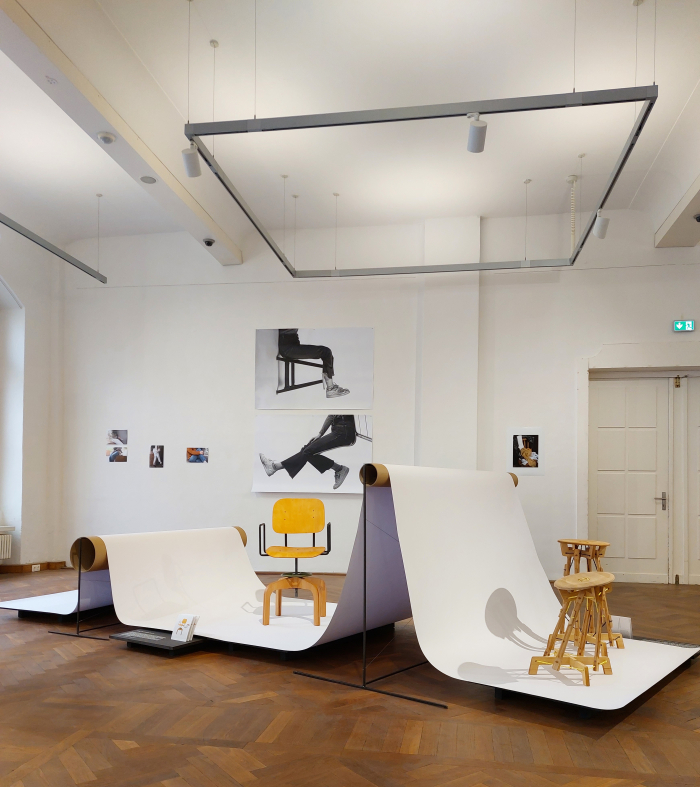
HOS_No1 by Viola Nauck (l) and Sitzseil Hocker by Felix Cordes (r), and uncredited photos, as seen at Sitting reconsidered. Design, Observe, Stage, the Burg Galerie, Halle
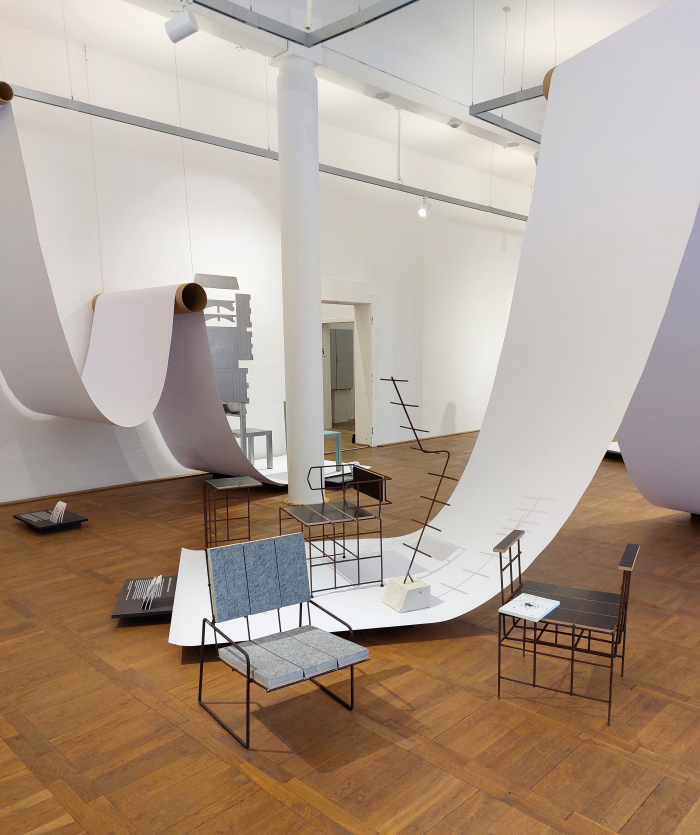
Baustahl collection by Luc Sohrmann, as seen at Sitting reconsidered. Design, Observe, Stage, the Burg Galerie, Halle
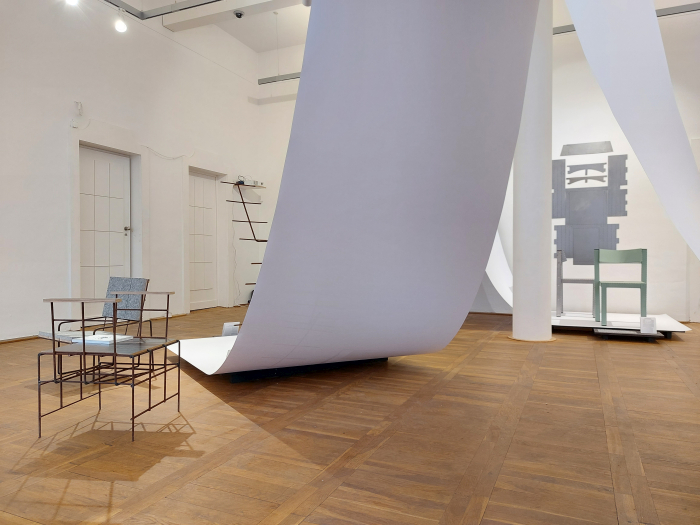
0.5 by Karl Schinkel (r) and part of the Baustahl collection by Luc Sohrmann (l), as seen at Sitting reconsidered. Design, Observe, Stage, the Burg Galerie, Halle
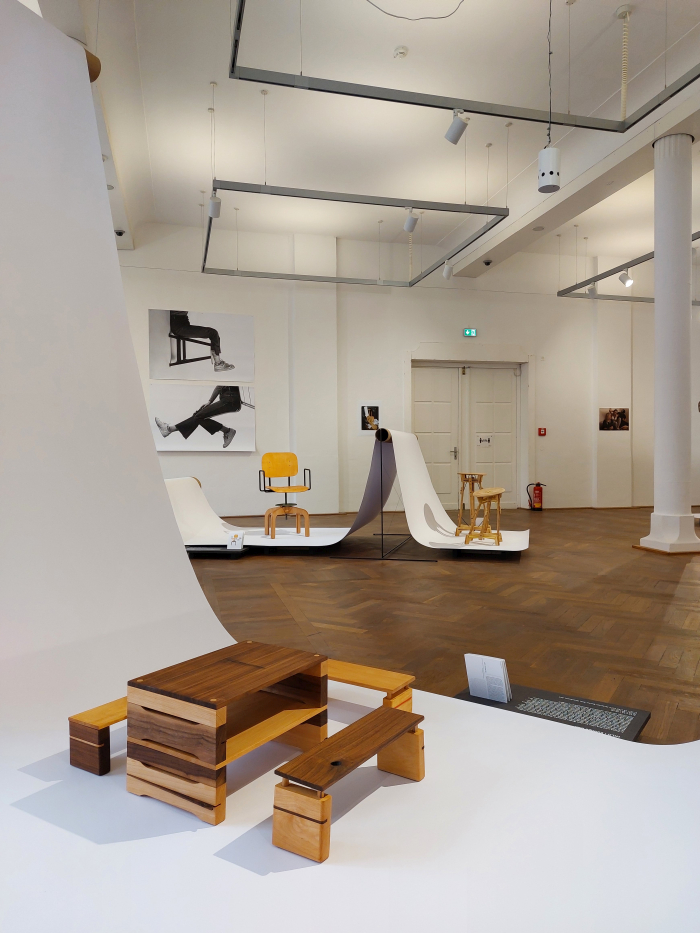
Hilo by Eunhye Bak, as seen at Sitting reconsidered. Design, Observe, Stage, the Burg Galerie, Halle
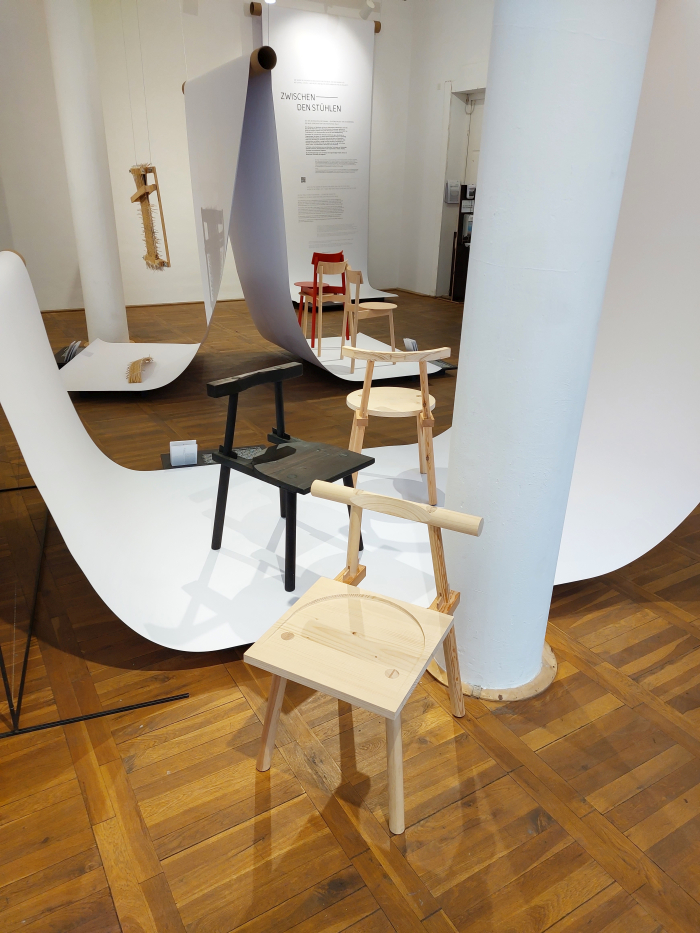
Ohne by Johann Post, as seen at Sitting reconsidered. Design, Observe, Stage, the Burg Galerie, Halle
1. Sitzen is Burg Education Box 02, Burg Education Box 01 was titled Walks and concerned itself with “self-determination, freedom and regulations, hierarchy and togetherness“. While walking.
2. Zwischen can be, for example, amongst or between or inside or inter- or in between or in the midst of or…….
3. “Das Projektitel “Zwischen den Stühlen” verrät besonders eines. Es geht nicht in erster Linie um die Objekte selbst, sondern um das “Dazwischen”” Konrad Lohöfener, Zwischen den Sühlen, in Zwischen den Stühlen, Burg Giebichenstein Kunsthochschule Halle 2022, page 18. Or online at https://www.burg-halle.de/zwischendenstuehlen/ (accessed 22.02.2022)
4. Back in 2012 we asked the, then, head of the Vitra airport division why benches at airports had armrests rather than allowing weary travellers to lay down, and were told “when people lie on benches at airports, one person takes up a whole bench. And then the airport’s capacity calculations don’t work. I have three seats, but only one user“. Now, we’re not going to compare the problems of air travellers with the problems of the homeless, that would be ridiculous; but it is interesting to note that the same device can be applied in different contexts to achieve the same control function; that simple devices can be freely used across society. And if that is the case with armrests, it is invariably the case with other, physical and non-physical, control devices. Which means……?
Tagged with: Burg Galerie im Volkspark, Burg Giebichenstein, chairs, Chairs. Dieckmann!, Erich Dieckmann, Halle, Konrad Lohöfener, sitting, Sitting reconsidered, Zwischen den Stühlen
